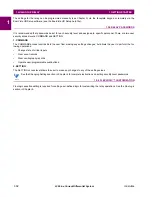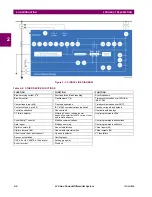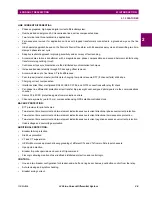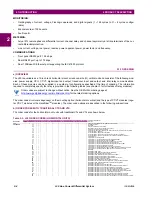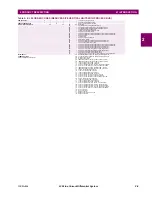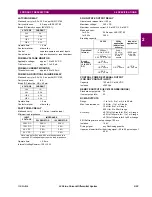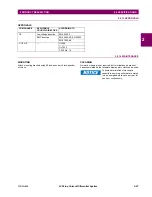
2-12
L30 Line Current Differential System
GE Multilin
2.2 PILOT CHANNEL RELAYING
2 PRODUCT DESCRIPTION
2
2.2PILOT CHANNEL RELAYING
2.2.1 INTER-RELAY COMMUNICATIONS
Dedicated inter-relay communications may operate over 64 kbps digital channels or dedicated fiber optic channels. Avail-
able interfaces include:
•
RS422 at 64 kbps
•
G.703 at 64 kbps
•
Dedicated fiber optics at 64 kbps. The fiber optic options include:
–
820 nm multi-mode fiber with an LED transmitter.
–
1300 nm multi-mode fiber with an LED transmitter.
–
1300 nm single-mode fiber with an ELED transmitter.
–
1300 nm single-mode fiber with a laser transmitter.
–
1550 nm single-mode fiber with a laser transmitter.
–
IEEE C37.94 820 nm multi-mode fiber with an LED transmitter.
All fiber optic options use an ST connector. L30 models are available for use on two or three terminal lines. A two terminal
line application requires one bidirectional channel. However, in two terminal line applications, it is also possible to use an
L30 relay with two bidirectional channels. The second bidirectional channel will provide a redundant backup channel with
automatic switchover if the first channel fails.
The L30 current differential relay is designed to function in a peer-to-peer or master-to-master architecture. In the peer-to-
peer architecture, all relays in the system are identical and perform identical functions in the current differential scheme. In
order for every relay on the line to be a peer, each relay must be able to communicate with all of the other relays. If there is
a failure in communications among the relays, the relays will revert to a master-to-peer architecture on a three-terminal sys-
tem, with the master as the relay that has current phasors from all terminals. Using two different operational modes
increases the dependability of the current differential scheme on a three-terminal system by reducing reliance on communi-
cations.
The main difference between a master and a slave L30 is that only a master relay performs the actual current differential
calculation, and only a master relay communicates with the relays at all other terminals of the protected line.
At least one master L30 relay must have live communications to all other terminals in the current differential scheme; the
other L30 relays on that line may operate as slave relays. All master relays in the scheme will be equal, and each will per-
form all functions. Each L30 relay in the scheme will determine if it is a master by comparing the number of terminals on the
line to the number of active communication channels.
The slave terminals only communicate with the master; there is no slave-to-slave communications path. As a result, a slave
L30 relay cannot calculate the differential current. When a master L30 relay issues a local trip signal, it also sends a direct
transfer trip (DTT) signal to all of the other L30 relays on the protected line.
If a slave L30 relay issues a trip from one of its backup functions, it can send a transfer trip signal to its master and other
slave relays if such option is designated. Because a slave cannot communicate with all the relays in the differential
scheme, the master will then “broadcast” the direct transfer trip (DTT) signal to all other terminals.
The slave L30 Relay performs the following functions:
•
Samples currents and voltages.
•
Removes DC offset from the current via the mimic algorithm.
•
Creates phaselets.
•
Calculates sum of squares data.
•
Transmits current data to all master L30 relays.
•
Performs all local relaying functions.
•
Receives current differential DTT and Direct Input signals from all other L30 relays.
•
Transmits direct output signals to all communicating relays.
•
Sends synchronization information of local clock to all other L30 clocks.
Summary of Contents for L30
Page 10: ...x L30 Line Current Differential System GE Multilin TABLE OF CONTENTS ...
Page 30: ...1 20 L30 Line Current Differential System GE Multilin 1 5 USING THE RELAY 1 GETTING STARTED 1 ...
Page 370: ...5 244 L30 Line Current Differential System GE Multilin 5 10 TESTING 5 SETTINGS 5 ...
Page 464: ...A 10 L30 Line Current Differential System GE Multilin A 1 PARAMETER LISTS APPENDIX A A ...
Page 600: ...C 30 L30 Line Current Differential System GE Multilin C 7 LOGICAL NODES APPENDIX C C ...
Page 610: ...D 10 L30 Line Current Differential System GE Multilin D 1 IEC 60870 5 104 APPENDIX D D ...
Page 622: ...E 12 L30 Line Current Differential System GE Multilin E 2 DNP POINT LISTS APPENDIX E E ...
Page 634: ...F 12 L30 Line Current Differential System GE Multilin F 3 WARRANTY APPENDIX F F ...
Page 644: ...x L30 Line Current Differential System GE Multilin INDEX ...

